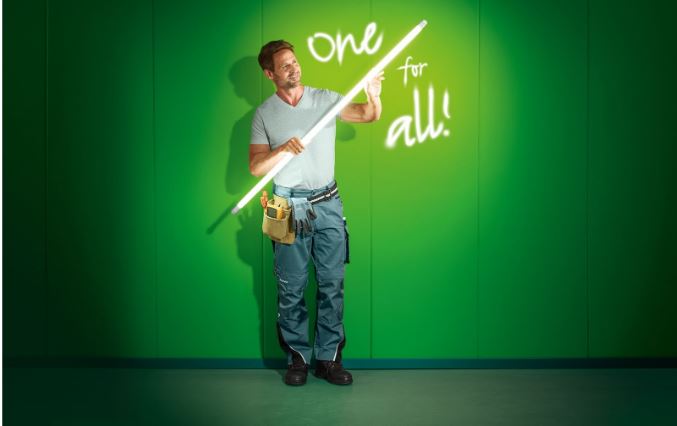Why Choose Fluorescent Lights?
Fluorescent lighting continues to be a popular choice for both residential and commercial spaces. Here’s why:
1. Energy Efficiency
One of the most significant benefits of fluorescent lighting is its energy efficiency. Fluorescent lights use about 25-35% less energy than traditional incandescent or halogen bulbs. For instance, a 20-watt fluorescent bulb can produce the same light output as a 75-watt incandescent bulb, making it an excellent choice for reducing energy consumption.
2. Cost Savings
The energy savings offered by fluorescent lights translate into lower electricity bills. While the upfront cost of fluorescent bulbs may be higher than traditional lighting, the long-term savings on your energy bill can offset the initial expense.
3. Long Service Life
Fluorescent bulbs are designed to last much longer than incandescent bulbs. A typical fluorescent bulb can last up to 10,000 hours, with some lasting as long as 50,000 hours, compared to the 800-1,500 hours of an incandescent bulb. This extended lifespan reduces the need for frequent replacements, making fluorescent lights a low-maintenance option.
Drawbacks of Fluorescent Lighting
While fluorescent lights offer numerous advantages, they come with a few notable drawbacks. One of the primary concerns is the presence of mercury within the bulbs. Although the amount is minimal, mercury is a toxic substance, and its release during bulb breakage requires careful handling and proper recycling to avoid environmental harm. Additionally, the initial cost of fluorescent lights tends to be higher compared to traditional incandescent or halogen bulbs, partly due to the need for ballasts to regulate electrical currents. This can increase the overall installation expense. Another limitation is the restricted dimming capability of fluorescent lights. Not all models support dimming, and those that do often require specific and sometimes costly ballasts, which can be inconvenient to replace. These factors may limit the suitability of fluorescent lights in settings where adjustable lighting is essential, such as home theaters or restaurants.
Why Fluorescent Light Bulbs Need a Ballast
The ballast in a fluorescent light serves an important role: it regulates the flow of electricity through the bulb. Since fluorescent lamps require a steady current to operate, the ballast ensures the current is stable, preventing flickering and damage to the bulb.
Ballasts come in different types, including:
Magnetic ballasts (older technology)
Electronic ballasts (more efficient, common in modern applications)
When replacing a fluorescent bulb, it’s essential to ensure compatibility with the ballast to maintain optimal performance and efficiency.

How to Properly Recycle Fluorescent Lamps
Due to the mercury contained in fluorescent lamps, recycling fluorescent lights properly is crucial for environmental safety. Here's how to do it safely:
If the lamp is intact, turn off the power, remove the housing, and unscrew the bulb. Take it to the nearest recycling center that accepts hazardous waste.
If the lamp breaks, evacuate the area immediately, ventilate the room, and wear gloves to clean up the broken pieces. Place the broken bulb and residue in a sealed container and take it to a certified recycling facility.
Fluorescent Lighting from LEDVANCE
LEDVANCE offers a wide range of fluorescent lighting solutions, including compact, linear, U-bend, and round fluorescent lamps. Our energy-efficient T8, T5, and CF fluorescent lamps are perfect for reducing operating costs and enhancing energy efficiency in your lighting system. Many of our fluorescent lamps are compatible with QUICKTRONIC® electronic ballasts, which further improve energy savings.
OCTRON® T8 lamps, introduced over 30 years ago, are now more energy-efficient than ever, offering significant savings compared to older T12 lamps. Plus, with utility rebates available, you can reduce your initial installation costs even further.
FAQs About Fluorescent Lighting
1. How long do fluorescent lights last?
Fluorescent lights typically last 10,000 to 50,000 hours, far outlasting traditional incandescent bulbs.
2. Are fluorescent lights energy-efficient?
Yes, fluorescent lights use 25-35% less energy than traditional incandescent bulbs, making them a highly efficient lighting solution.
3. How do you recycle fluorescent lights?
Fluorescent bulbs contain mercury and must be disposed of properly. Take used or broken bulbs to a certified recycling facility to prevent environmental harm.
4. Can you dim fluorescent lights?
Some fluorescent lights are dimmable, but not all models are compatible with dimming. Be sure to check if your bulb and ballast support dimming before installation.
Conclusion
Fluorescent lighting offers numerous benefits, including energy efficiency, long lifespan, and cost savings. However, it’s essential to be aware of the potential downsides, such as mercury content and limited dimming options. By choosing the right fluorescent lighting system and properly maintaining and recycling your bulbs, you can make the most of this reliable and energy-efficient lighting solution.
If you’re looking to upgrade your lighting, consider LEDVANCE's wide selection of energy-efficient fluorescent lighting options, designed to help you save on both installation and energy costs.



